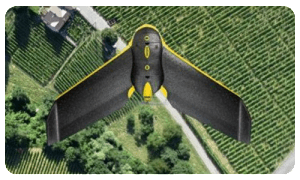By Carter Chute, University of Saskatchewan student
Every grain farmer knows the importance of crop scouting, if a nasty bug or disease goes unnoticed that could mean a serious hit to profits. There are two major issues with crop scouting: time and coverage. Often farmers do not have the time to walk a whole field and examine plants throughout the field. They already have ten other things they need to do and while passing by the field they stop to look. Thorough scouting is another issue with time. A bug rarely attacks an entire field, and fungus or disease often don’t spread evenly through the field. Instead, they cluster in random pockets and are difficult to find. Even with a thorough check, one can miss something that does not want to be found. This can lead to plant damaging issues to slip through the cracks, hurting profits and pride.
Drones are a high-tech yet a simple solution to the time and coverage issue of crop scouting. Drone technology has advanced greatly in the last five years and has opened new and exciting options. A simple drone, equipped with geographic information system GIS Mapping and high-resolution Normalized Difference Vegetation Index (NDVI) cameras can fly over 100 acres in 20 minutes, and provide a detailed map of your field with the ability to detect plants that are stressed or unhealthy. With an infrared camera, a drone can detect nitrogen deficiencies long before the visible eye. The farmer now has a complete image of their field, with enough information to keep the field healthy, completed from the side of the road. This data can lead to the creation of variable rate maps for spraying of pesticides, fungicides, an in-crop fertilization application and much more, advancing the way that farmers monitor their crops.
 Drone prices vary from affordable for the average consumer to large corporation price range, with a full drone package including software reaching over $20,000. The average drone for agriculture use comes with software to convert the drone’s images from GIS and NDVI to usable data for the farmer, such as the creation of the yield and crop health maps. These maps can be converted to variable rate maps that can be used for applying fungicides, pesticides, in-crop fertilizer and others at a precise area and rate. While some drone packages seem to cost a considerable amount, they all claim that the costs can be easily recovered in a season or two from all the advantages that the drones provide.
Drone prices vary from affordable for the average consumer to large corporation price range, with a full drone package including software reaching over $20,000. The average drone for agriculture use comes with software to convert the drone’s images from GIS and NDVI to usable data for the farmer, such as the creation of the yield and crop health maps. These maps can be converted to variable rate maps that can be used for applying fungicides, pesticides, in-crop fertilizer and others at a precise area and rate. While some drone packages seem to cost a considerable amount, they all claim that the costs can be easily recovered in a season or two from all the advantages that the drones provide.
While it is clear there are many positives to this technology, there are some issues. Some critics raise the concern of mid-air collisions with airplanes and the more sensitive helicopter. While these could cause a serious problem, proper training and awareness could easily solve these problems. One issue that remains a thorn in the side is privacy and how to respect it. Drones are small, are hard to spot and very quiet, with really good cameras. This obviously can lead to problems and has already made appearances in newspapers as an issue.
I believe drone technology is key to the future of agriculture, beyond field scouting into all areas of farming. The potential is incredible, for example, it could solve the shortage of skilled farm employees with unmanned farm equipment. Ultimately, I feel the benefits outweigh the costs for farmers, providing new ways of farm and crop management through precision and data collection. While this technology is not new, it is to the agriculture industry. In the next 10-15 years, drones could be adapted allowing farmers to operate multiple drones to complete day-to-day tasks, addressing the challenge of a shrinking workforce.

Carter Chute
Carter is in his third year of a Bachelor of Science in Agribusiness at the University of Saskatchewan. Born and raised on a farm near Moose Jaw, Saskatchewan, Carter plans to return to the farm after the completion of his degree. His interests include outdoor activities, sports, video games and coffee.


